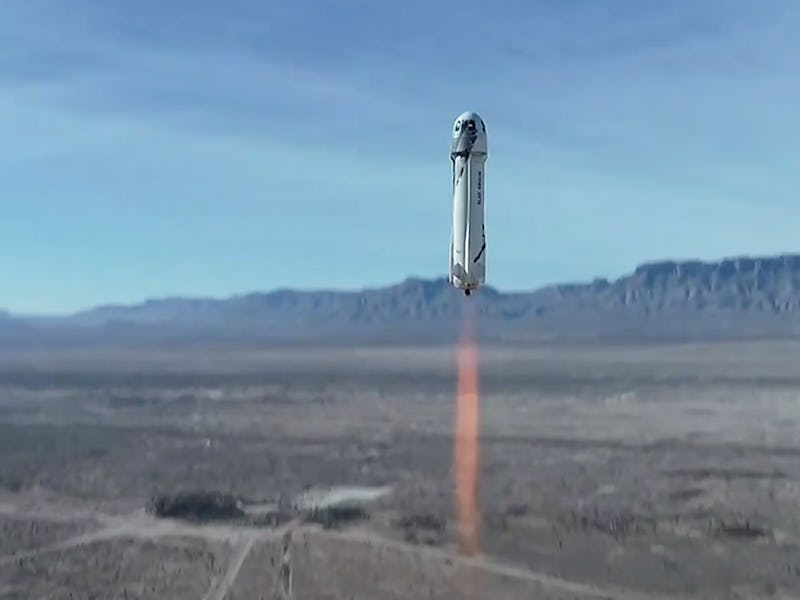Blue Origin steps toward human spaceflight with stunning launch video
Jeff Bezos' space-faring firm has completed its 14th New Shepard mission, with a slew of upgrades dedicated to human spaceflight.

Liftoff! Blue Origin successfully launched the 14th New Shepard mission Thursday, sending its crew capsule into space and taking the biggest step yet toward making human spaceflight a reality for the company.
The mission, which launched at 11:17 a.m. Central time from Blue Origin's West Texas site, launched the firm's latest crew capsule design, fitted with an array of upgrades designed to make flights more comfortable.
Its sole occupant, a dummy dubbed "Mannequin Skywalker," sat in one of the capsule's six seats.
Watch the replay of Thursday's launch below:
This latest success brings commercial human spaceflight closer than ever for the firm. The company, founded by Amazon CEO Jeff Bezos, plans to launch up to six people into space with the New Shepard rocket. The capsule will fly past the Kármán line, the 100-kilometer-high border that separates Earth's atmosphere from outer space. Passengers will feel forces three times stronger than Earth's gravity as they enter space and float back down to West Texas.
These brief trips to space are designed purely for enjoyment, not to take astronauts out to the International Space Station, or even Mars, a la SpaceX's Crew Dragon. The cabin is 530 cubic feet, with windows that can transmit 92 percent of visible light. Astronauts will be invited to take off their harness, float around the cabin, and practice some moves before they return to Earth.
Thursday's flight was the first for this iteration of the New Shepard's booster, the fourth New Shepard booster overall. The first two booster designs have been retired, while the third has completed seven successful missions in a row from December 2017 to October 2020. The first three carried uncrewed payloads to space, but booster four will be used in crewed missions, according to the firm.
In preliminary post-launch statistics, the team announced the crew capsule reached an apogee of 350,827 feet. It reached a maximum ascent velocity of 2,242 miles per hour over the course of the flight, which lasted 10 minutes and 15 seconds.
This foray was aimed at finessing the systems to make these flights feel smooth. The capsule featured new acoustics and temperature regulation, microphones and speakers, push-to-talk buttons for all six seats so passengers can talk to Mission Control, and crew display panels.
The capsule also sported new safety and alert systems. These included lights and sounds in each passenger's seat for delivering safety messages. The walls are lined with padding, so passengers won't hurt themselves as they float around.
Blue Origin's plans for flights.
The flight featured another tweak aimed at making these flights more impressive for passengers. Around 16 seconds after launch, the booster started rotating at two to three degrees per second. This functionality is aimed at giving passengers a better view of the landscape below during their trip.
The booster pivoted dramatically during the landing, as the BE-3 engine worked to reposition the vehicle to the center of the pad.
"That's the type of stuff that makes live rocket launches and landings so exciting," Ariane Cornell, Blue Origin's director of astronaut and orbital sales, said during the mission's livestream.
The mission also sent up over 50,000 postcards, submitted from students worldwide as part of the Club for the Future initiative. This is the third mission to feature such postcards, some of which were placed in "Mannequin Skywalker"'s pockets.
The Inverse analysis — Blue Origin is aiming for the space tourism crowd with New Shepard. It's a similar approach to Virgin Galactic, which aims to offer similar suborbital flights just past the Kármán line. The latter firm detailed its cabin and interior in a July 2020 reveal.
It's unclear when humans will fly on New Shepard, pandemic aside. Bezos told SpaceNews in February 2019 that humans would fly that year. But company officials told SpaceNews in February 2020 they may need to host three or four more uncrewed flights before putting people on board.
With Thursday's mission, the goal may have come closer than ever.
This article was originally published on